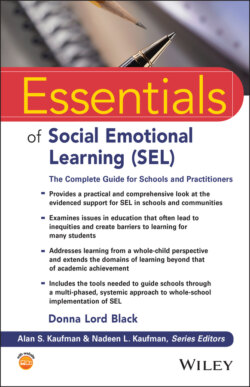Читать книгу Essentials of Social Emotional Learning (SEL) - Donna Lord Black - Страница 26
DEFINING SEL
ОглавлениеOne of the most difficult challenges at the outset of implementation is that of understanding and agreeing on what SEL is. The ambiguity in defining SEL has led to many terms being used to describe it. While some refer to it as soft skills, others use terms like non‐cognitive skills, emotional intelligence, or character education to describe it. Some prefer to describe SEL through programming models such as mindfulness education or through frameworks such as Positive Behavior Interventions and Supports (PBIS). Not only is there a lack of common language in describing SEL, but also studies indicate there is a lack of understanding and agreement on the perceived benefits of SEL. While parents and educators understand and agree that SEL skills are critically important, there is less agreement on the exact benefits of these skills. In a study conducted by the World Economic Forum (2016), more than 2000 educators and parents from around the world were surveyed regarding the perceived benefits of SEL. Results showed that educators and parents alike believed the primary benefit of SEL was to achieve better classroom management and discipline. In a large majority of those surveyed, there was less understanding of the broad benefits of SEL, such as how it impacts academic achievement, or college and career readiness. There also was less awareness of the role SEL can play in improving general health and in mitigating the negative effects that can occur from exposure to some of life’s most difficult challenges, such as poverty, violence, trauma, abuse, and neglect.
Take, for example, the Anchorage School District in Alaska. The largest district in a state that ranks among the highest per capita in rates of child abuse and domestic violence, this district has more students exposed to violence and trauma than in most other states (Boss, 2011). Exposure to these types of adverse childhood experiences (ACEs) places these students at risk for poor educational, social, health, and economic outcomes. The Anchorage School District recognized the need to combat these risk factors, and in 2006 it became one of the first school districts in the United States to adopt a set of SEL standards for both students and teachers (Education First, 2016). Since then, these standards have been implemented in kindergarten through 12th grade classes and have transformed the business of educating students in the Anchorage School District (Davis, 2018). Is it working? Educators and parents alike believe it is making a difference, but results aren’t that easy to quantify. That may be because the skills themselves aren’t easy to quantify, and without high‐quality assessment tools to help, educators won’t be able to determine which instructional strategies work and which ones are ineffective and may be wasting critical resources.
The science behind SEL recognizes the need for resources to help clarify and provide guidance in assessing and quantifying these skills, but this field is just beginning to grow, albeit rapidly. While data can and should be used to help inform and guide instruction (and, thus, ensure adequate use of resources), it’s also important to understand that the purpose for the data is not to detract from other important activities, but to enhance those activities.
